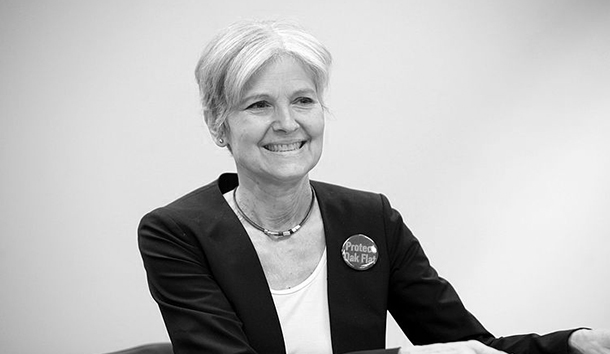A subplot of the 2016 presidential campaign was the Green Party’s ability, for the second time in the 21st century, to achieve balance of power in a close race won by a Republican. Physician Jill Stein, 66, earned 1.4 million votes, or one percent—a miniscule amount, but more than the difference between Republican Donald Trump and Democrat Hillary Clinton in the states of New Hampshire, Michigan, and Wisconsin. The latter two were part of Clinton’s so-called Blue Wall, and Trump won both of them. He increased his Electoral College victory by also winning Ohio and Pennsylvania, taking the Industrial North for a Republican ticket for the first time since 1984.
Stein’s achievement was a reminder that Democrats have learned little and forgotten much about their party’s historical role co-opting third-party ideas and votes. In 2000, Green candidate Ralph Nader achieved balance of power in the popular vote and in seven states, including two (Florida and New Hampshire) won by Republican George W. Bush. The vote was enough for Bush to win the Electoral College by a narrow margin (271-266), though Gore won the popular vote by 543,895 ballots. Democrats vowed the Greens would not influence the outcome of another presidential race. One widely publicized app this year even allowed Clinton voters in Blue States to vote-trade with swing-state Stein supporters. But the tactic did not draw enough voters, and Stein attracted enough Bernie Sanders supporters in Midwest college towns to alter history.
Democrats vented their rage, postelection. MSNBC’s Rachel Maddow lambasted Stein for costing Clinton the race, a sentiment echoed by other liberals. New York Times columnist Paul Krugman tweeted, “Btw, Jill Stein has managed to play Ralph Nader. Without her Florida might have been saved.” (Stein’s combined tally with Libertarian Gary Johnson was more than the difference between Clinton and Trump.) According to Politico, Clinton researcher Navin Navak emailed Clinton campaign senior staff, telling them that,
In the end, less than 110K votes out of tens of millions cast on Election Day made the difference in this race. It is worth noting that Jill Stein alone got 130K votes in those three states—and though her votes don’t distribute perfectly to cover the margin across the three states, it is an important reminder of the influence of 3rd party votes.
The absence of any analysis explaining how Democrats might co-opt Green issues in a future race is telling.
Stein, like Nader before her, says Democrats are responsible for their own failures. Stein tweeted, “Bernie Sanders showed Democrats how to win, and they sabotaged him.” She opposed war with Russia. One piece comparing Stein’s and Clinton’s stances on Syria listed Stein’s position as “Pursue diplomacy in Syria, not military escalation,” and Clinton’s as “Confront Syria and Russia. No-fly zone.” Stein also tweeted, “Hillary Clinton’s foreign policy is much scarier than Donald Trump’s, who does not want to go to war with Russia.” Greens attacked Clinton for taking their votes for granted and ignoring issues like “ranked-choice” (or “instant run-off”) voting, approved in Maine on Election Day.
Ignoring issues and taking voters for granted is, to say the least, a flawed election strategy. Democrats ran the same play that failed in 2000, trotting out media proxies to lecture citizens that a Stein vote was equivalent to a Trump vote. In “From Jill Stein, disturbing echoes of Ralph Nader,” Washington Post columnist Dana Milbank wrote, “Trump’s narrow path to the presidency requires Stein to do well in November, and polls indicate Trump does better with her in the race.” Oddly enough, the Democratic Party’s own history suggests that they have a better understanding of third-party balance of power. The concept allows third parties to leverage their ideas. Examples include the Greenback, Populist, Progressive, and Socialist parties. None won the White House, though economic planks from their platforms were later co-opted by Democrats Woodrow Wilson and Franklin Delano Roosevelt. Hillary Clinton, by contrast, did not co-opt Green issues—unless we count her support of Stein’s failed postelection recount efforts in Wisconsin, Michigan, and Pennsylvania.
The Green vote peaked with Nader, though the party’s congressional vote nearly tripled from 1992 to 2012 and includes seven House races where Greens earned balance of power and Republicans won. The Greens claim at least 137 officeholders in 16 states. They have ballot access in 19, according to Ballot Access News.
The Greens could tip the scales again because Democrats have failed to listen to the concerns of several constituencies, including antiwar students. In Michigan, Stein ran strongest in college counties (Ingham, Isabella, Marquette) and in the Upper Peninsula, with its struggling mining sector. In Wisconsin, she did best in Vernon County, home of Organic Valley, the world’s largest family-farm cooperative; two counties near the U.P. border; and Dane County, home of the University of Wisconsin. Beating the drums for war with Russia was a failed strategy in the 2016 presidential sweepstakes, yet Democrats continue to bang on.
[Image credit: By Gage Skidmore from Peoria, AZ, United States of America (Jill Stein) [CC BY-SA 2.0]]

Leave a Reply